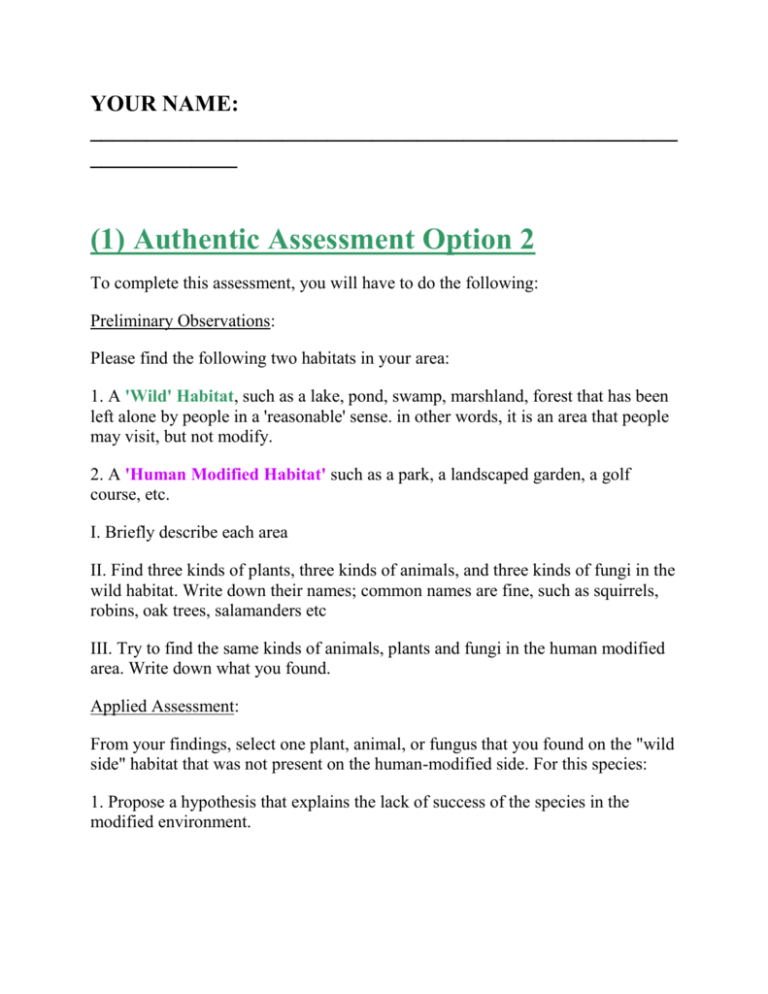bio_final - Homework Market
advertisement

YOUR NAME: ____________________________________________________ _____________ (1) Authentic Assessment Option 2 To complete this assessment, you will have to do the following: Preliminary Observations: Please find the following two habitats in your area: 1. A 'Wild' Habitat, such as a lake, pond, swamp, marshland, forest that has been left alone by people in a 'reasonable' sense. in other words, it is an area that people may visit, but not modify. 2. A 'Human Modified Habitat' such as a park, a landscaped garden, a golf course, etc. I. Briefly describe each area II. Find three kinds of plants, three kinds of animals, and three kinds of fungi in the wild habitat. Write down their names; common names are fine, such as squirrels, robins, oak trees, salamanders etc III. Try to find the same kinds of animals, plants and fungi in the human modified area. Write down what you found. Applied Assessment: From your findings, select one plant, animal, or fungus that you found on the "wild side" habitat that was not present on the human-modified side. For this species: 1. Propose a hypothesis that explains the lack of success of the species in the modified environment. 2. Design an experiment to test your hypothesis. Provide a detailed account of the materials and methods used to conduct the experiment. Also include the methods for data collection and analysis. 3. Conduct a literature search to find studies that identify factors that contribute to the success of your species in the selected habitat. List those factors, and explain how they help the species survive. 4. Conduct a literature search to find studies that identify factors that contribute to the lack of success of your species in the selected habitat. List those factors, and explain how they did not help the species to survive. Discuss whether these factors support your hypothesis. (2) Authentic Assessment Option 1 Design an experiment in which you will test the effect of an acidic fluid on enzymatic activity. (Recall: enzymes are proteins.) To complete this project, it may be useful for you to review the Scientific Method Tutorial (found the Course Content section of the classroom under the Science Learning Center link) and the Scientific Method lab (Lab 1), so that you can better understand how to design an experiment. It may also be helpful for you to review your textbook and Lab 4 (Enzymes). As you review Lab 4, you will be reminded that there are several factors that impact enzymatic activity: pH, temperature, and amount of reagent. Feel free to refer to observations and information from Lab 4 as you complete the questions required in the Final Applied Project (see the questions below). As you design your experiment for this project, please remember that you are trying to examine how an acidic fluid will modify the outcome of an enzymatic reaction. To successfully complete this project, you will need to identify the question(s) being asked in your experiment and the hypothesis that you are testing. In your experimental design, you must clearly explain what you are doing. That means that you will need to identify the enzyme and the acid, as well as explain your experimental protocol (this information will help you to answer question 2). You must also thoroughly explain how the addition of the acidic fluid impacted the overall reaction process (this information will help you to answer question 4). Hint: Keep in mind that the acid will change the environmental conditions of the experiment (for example, a low pH value could change the shape of the active site on the enzyme protein), without directly participating in the reaction. Lab Materials You may need the following, depending on your experimental design: Materials in your lab kit: none Additional materials you may need: plastic beakers or cups hydrogen peroxide solution (from Lab 4) yeast (from Lab 4) sample of fresh meat, about 1 cm cubed in size (unprocessed and uncooked, e.g., liver, steak, fish, or poultry—particularly organs) sample of fresh vegetable, about 1 cm cubed in size (e.g., potatoes or other root vegetables) a pen for labeling the beakers or cups a ruler with centimeter markings Remember, the goal of this project is for you to evaluate the effect of an acid on enzymatic activity. As part of this assignment, you must identify your source of enzyme and the acid used. As you work though this project, you must also make sure that the following questions/points are addressed: 1. What question are you asking? Clearly state your hypothesis. 2. Design an experiment. Provide a detailed account of the materials and methods used to conduct the experiment. Also include the methods for data collection and analysis. 3. Conduct the experiment and record your results below. What did you observe? Which samples showed bubbling? 4. Use your knowledge about enzymes to interpret your results. It may be necessary for you to refer to your textbook. What effect does the acid have on the enzyme? 5. Was your hypothesis supported? What is your conclusion? 6. Cite all references used to complete your Final Applied Project. Grading Criteria for the Final Applied Lab Project: You may earn up to 50 (fifty) points for this project, which will contribute 22% to your final grade. The success of this assignment depends on the thoroughness of your experiments and habitat investigation, your experimental design, your observation skills, the literature search, and analytical interpretation skills. I would prefer that you do Option 2, but Option 1 is, of course, acceptable as well. I will provide you with more detailed grading information for e











